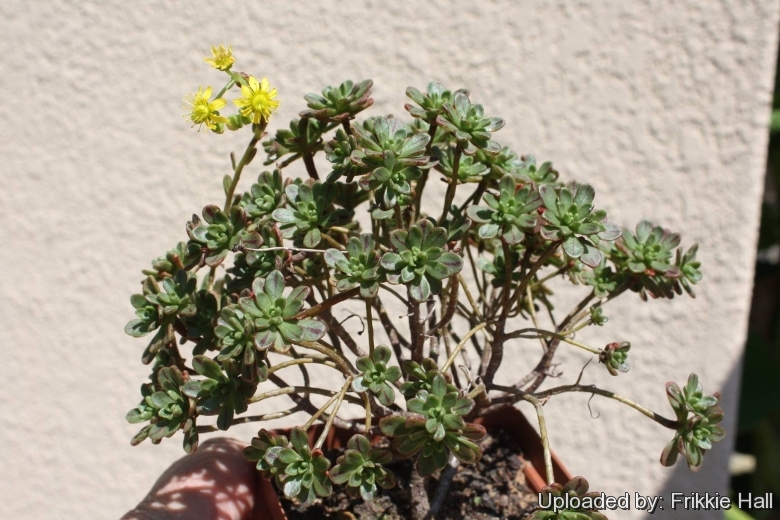
Aeonium sedifolium Photo by: Frikkie Hall
Origin and Habitat: Tenerife 27270]SN|27270]] is a narrow endemic species of highly specialized habit. The vegetative branches of form a compact mass, and the plants are typically scattered on very dry cliffs. When in flower, many inflorescences develop simultaneously which provide a conspicuous bright yellow cover.
Synonyms:
See all synonyms of Aeonium sedifolium
back
Accepted name in llifle Database:Aeonium sedifolium (Webb ex Bolle) Pit. & ProustIles Canaries 193 1908Synonymy: 5
back
Common Names include:
CHINESE (中文): 小人祭
SPANISH (Español): Bejequillo menudo
Description: Aeonium sedifoliumSN|34934]]SN|27270]] is a perennial densely branched shrublets to 40 cm. It can be easily identified by its dense, dwarf habit and very small shinny sticky leaves marked with crimson lines at the apex. Aeonium sedifolium is the smallest-leaved Aeonium commonly in cultivation.
Derivation of specific name: 'sedifolium' comes from 'Sedum', which is another genus in Crassulaceae family, and 'folius', meaning "foliage", ie possessing leaves similar to sedum.
Stems: Branches 1 - 5 mm in diameter, sparsely puberulent, viscid, smooth, without reticulations.
Rosettes: 4-3 cm in diameter, rather flattish, inner leaves more or less erect, imbricate and forming a globose bud during the dry season.
Leaves: 7-15 mm long, 4-10 mm wide, 3-5 mm thick, ovate or obovate, glossy, finely hairy, viscid and sticky, green to yellowish-green, lower face with reddish stripes, variegated with many brownish lines near the apex. The hairs on the leaves (multicellular trichomes ) are microscopic invisible to the naked eye.
Inflorescences: Lax, commonly 6- to 15-flowered, floriferous part 2-7 x 2-5 cm. Peduncle 2-8 cm. Pedicel 5-16 mm, puberulent.
Flower: 9- to 11-merous. Sepals puberulent. Petals 5-7 mm long, 2-2.5 mm wide, obovate or oblanceolate, acute or obtuse, yellow. Filaments sparsely puberulent. Nectariferous glands absent.
Similar species: Aeonium sedifolium is closely related to Aeonium saundersii. Both species fold their young leaves into an imbricately globose structure during the dry season, but Aeonium sedifoliumSN|27270]]SN|27270]] has smaller (usually less than 1 cm long) and thicker (usually more than 3 mm thick) leaves with pale-reddish tannic stripes underneath. Aeonium sedifoliumSN|27270]]SN|27270]] is known to hybridize with Aeonium canariense var. palmensis, Aeonium davidbramwellii, Aeonium goochiae, Aeonium haworthii, and Aeonium urbicumSN|27270]]SN|34934]].
Chromosome number: 2n = 18.
Bibliography: Major references and further lectures
1) Ho-yih Liu “Systematics of Aeonium (Crassulaceae)” National Museum of Natural Science, 1989
2) Urs Eggli “Illustrated Handbook of Succulent Plants: Crassulaceae” Springer Berlin Heidelberg, 05/Nov/2012
3) John Robert Brown, Alain Campbell White, Boyd L. Sloane, George W. Reynolds “Succulents for the amateur: introducing the beginner to more than eight hundred fascinating succulent plants” Abbey garden press, 1946
4) J. F. Ardévol González, Liv Borgen, Pedro L. Pérez de Paz “Checklist of chromosome numbers counted in Canarian vascular plants” Botanical Garden and Museum, University of Oslo, 1993
5) Donna Kuroda “Amazing aeoniums: A Journey to Travel the Wide World of
Aeoniums” 16 October 2011 retrieved 15 May 2016 from <http://www.washington-dc.cactus-society.org/Newsletter/Aeoniums.pdf>
Cultivation and Propagation: Aeonium sedifoliumSN|27270]]SN|27270]] is the most delightful of the miniature aeoniums and not easy to recognize as an Aeonium. The plants tend to go dormant in the summer and look a little tired sometimes, but they perk up again in the fall. Summer is the natural dormant season for this species in its native land. Suitable for indoor culture it can be grown in shade, but needs sun to bring out full colour.
Soil. It requires gritty well drained potting mix.
Water requirements: Water deeply but infrequently. Plants are allowed to thoroughly dry in-between waterings. During the winter months restrict water to about once a month, or just enough to keep the foliage from shrivelling.
Exposure: Position in full to part sun in a sheltered spot, but the bright light enhances the rich red hues of the foliage, but prefers light shade to shade in summer.
Hardiness: Needs protection from severe winter frosts (Hardy to -2°C or a little less for short periods), over winter under glass in all but the mildest of gardens.
Propagation: Aeonium sedifoliumSN|27270]]SN|27270]] is easily propagated by cuttings in the spring, just cut the top rosette with a piece of stem and plant it. It will soon take root, while the plant left with just the stem will soon grow new buds that can be in turn used for propagation. Time to take cuttings: April to July










